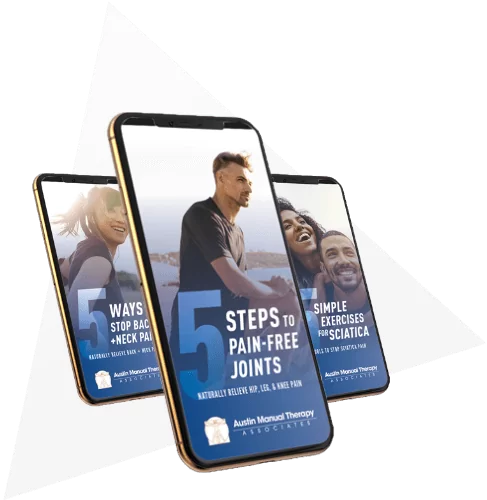Pain is a common occurrence. Except for those rare, lucky people who have no sense of pain, everyone else will experience some sort of physical discomfort in their lifetime. One of the most common reasons for experiencing pain is injuries sustained to the foot. Living with pain in your feet or ankles can definitely take a huge toll on your daily life. Your mobility can be affected, for example, you may notice that you can’t move as fast as you normally do because you’re limping. Or perhaps you have to sit down often to rub your feet or massage your ankles.
There’s no doubt about it: having a condition that pain and discomfort in these body parts is a sign that you need professional help.
Austin Manual Therapy provides physical therapy services to our patients in need of pain relief for foot and ankle discomfort.
Call us today to set up an appointment, and in the meantime, keep reading to learn more about the science behind foot pain, and how a skilled PT can help you get back up on your feet in no time.
Why does my foot hurt so badly?
While there are many different factors that could be leading to the discomfort you are feeling, some of the most common conditions of the foot and ankle that we treat are tendinitis, plantar fasciitis, and neuropathy. Let’s look at some of the reasons conditions such as these form, and why they cause so much pain and discomfort.
Tendinitis
Tendinitis is known as an “overuse injury,” because it develops over time. Because of this, it is a common condition that can arise in the feet and ankles.
Every bone in the body is connected with muscular fibers called tendons. The tendons are flexible, allowing the body to move freely by letting bones stretch apart or move in one direction or another. Tendinitis occurs when the tendons become inflamed, which can result in swelling and pain, especially with movement of the affected area.
Tendinitis that occurs in the feet or ankles is commonly referred to as Achilles tendinitis, since it develops in the Achilles tendon. It is also colloquially referred to as “runner’s ankles” or “runner’s heels.”
Neuropathy
Neuropathy refers to a disease state of nerves. This typically occurs in people who suffer from diabetes as this damages the nerves, especially in the feet. In addition, circulation issues can cause neuropathy to occur in the feet, legs or hands. Various factors, which contribute to poor circulation, can often be improved with physical therapy, which will improve the neuropathy to varying degrees.
Neuropathy can be especially problematic as the lack of sensation in the feet can lead to cuts or injuries without you even knowing. Since circulation is usually compromised, the chances of infection become high. A JOSPT study done on foot and ankle sensory neuropathy explains that the risk of injury increases with this condition due to decreased sensation on the bottom of your foot.
There is also the risk of fall-related injury associated with changes in other sensory systems of the foot and ankle, such as the receptors involved in joint movement and position perception.
Plantar fasciitis
Plantar fasciitis occurs as an inflammation of the “plantar fascia,” which is a long tissue at the bottom of your feet that connects from the heel bone to the toes. Because of the range of tissue, you may feel pain or soreness in your heel, toes, or the entirety of your foot’s underside.
People with plantar fasciitis also report their peak pain occurring in the morning, describing it as a “stabbing pain” that seems to alleviate mobility as the day progresses.
When understanding plantar fasciitis, it is important to also understand heel spurs. Heel spurs are calcium deposits that grow on the bottom of the heel and can cause bone-like protrusions to stick out of the flat underside of the heel. This can result in soreness or pain, which can develop into plantar fasciitis. Plantar fasciitis can develop on its own or as a symptomatic response to heel spurs.
An article published on JOSPT, titled “Plantar Fasciitis: Will Physical Therapy Help My Foot Pain?” states “In 2014, the Orthopaedic Section of the American Physical Therapy Association published updated clinical practice guidelines on the best treatments for patients with plantar fasciitis. The guidelines present evidence that strongly suggests a combination of manual therapy and rehabilitative exercises to help patients with this foot condition.”
It’s important to contact a physical therapist if you notice swelling or pain at the bottom of your foot, as it may be a sign of plantar fasciitis or a symptom of heel spurs.
Allow a physical therapist to take a closer look…
Injuries happen, and our feet are not exempt from experiencing pain. We depend on them to get us from point A to point B, so if you are giving you a hard time, it’s a good idea to call in the experts!
Physical therapy at Austin Manual Therapy in Austin TX can help you regain as much strength, flexibility, and range of motion as possible in your foot. A physical therapist may perform manual therapies and/or teach you exercises that you can do at home, depending on your injury or pain condition.
Our therapists are knowledgeable individuals who know a multitude of ways to effectively relieve and alleviate discomforts, such as the ones you may be feeling in your feet or ankles. They can also enhance your coordination and strength as well so you don’t sustain the same injury in the future.
Ready to get to the source of your foot pain?
Not all pain is created equally, but its experience is common. Remember that pain is not “normal” though, however common it may be!
We are the experts who know best. As Fellowship-trained Manual Therapists, we have the training and skill to help most everyone better manage these often intrusive and unrelenting foot pain symptoms. We can help you reclaim your life and enjoy doing the things you love without experiencing constant pain in your feet. Let us help you determine how to reclaim a more pain-free life.
We can assess your pain and create a customized treatment program catered towards your specific needs, so what are you waiting for? Pick up the phone and call us today.






